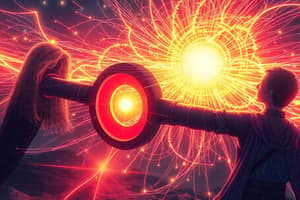Podcast
Questions and Answers
What is the branch of physics that deals with magnetism due to electric current?
What is the branch of physics that deals with magnetism due to electric current?
Electromagnetism
Who discovered the relation between electricity and magnetism?
Who discovered the relation between electricity and magnetism?
Orested
Orested showed that electric current through a conducting wire does not affect a magnetic needle held below the wire.
Orested showed that electric current through a conducting wire does not affect a magnetic needle held below the wire.
False (B)
When the direction of current in a conductor is reversed, the deflection of the magnetic needle also reverses.
When the direction of current in a conductor is reversed, the deflection of the magnetic needle also reverses.
What happens to the deflection of a magnetic needle when the current in the conductor is increased?
What happens to the deflection of a magnetic needle when the current in the conductor is increased?
A magnet at rest produces a magnetic field around it while an electric charge at rest produces an ______.
A magnet at rest produces a magnetic field around it while an electric charge at rest produces an ______.
An electric field can be produced without a charge.
An electric field can be produced without a charge.
A current-carrying conductor produces an electric field.
A current-carrying conductor produces an electric field.
What happens to the compass needle when current flows through the wire in Orested's experiment?
What happens to the compass needle when current flows through the wire in Orested's experiment?
What is the branch of physics that studies electric charges and magnetic fields?
What is the branch of physics that studies electric charges and magnetic fields?
What are the two types of electric charges?
What are the two types of electric charges?
What is the SI unit for electric charge?
What is the SI unit for electric charge?
What is the formula for the Lorentz Force Law?
What is the formula for the Lorentz Force Law?
What does electromagnetic induction refer to?
What does electromagnetic induction refer to?
Which of Maxwell's equations describes how changing electric fields produce magnetic fields?
Which of Maxwell's equations describes how changing electric fields produce magnetic fields?
What is the speed of electromagnetic waves in a vacuum?
What is the speed of electromagnetic waves in a vacuum?
Magnetic fields are produced only by magnets.
Magnetic fields are produced only by magnets.
The SI unit for magnetic field strength is ______.
The SI unit for magnetic field strength is ______.
Which application does NOT utilize principles of electromagnetism?
Which application does NOT utilize principles of electromagnetism?
Flashcards are hidden until you start studying
Study Notes
Electromagnetism
- The study of magnetism caused by electric current or moving charges.
- Electric current is essentially the movement of charges.
Oersted's Discovery
- Discovered that an electric current in a wire can affect a magnetic needle.
- The needle deflects when current is present.
- Reversing the current direction reverses the needle's deflection.
- Increasing the current or bringing the needle closer to the wire increases the deflection.
- This demonstrates that a magnetic field exists around a current-carrying conductor.
Key Concepts
- A stationary magnet produces a magnetic field.
- A stationary electric charge produces an electric field.
- A current-carrying conductor produces a magnetic field.
- A moving charge produces both an electric and a magnetic field.
- An electric field requires a charge to exist, but a magnetic field can exist without a magnet.
- A coil carrying current doesn't create magnetic poles, but acts as a magnet.
Electromagnetism
- The study of electric charges, magnetic fields, and how they interact.
Electric Charges
- Two types: positive (+) and negative (-).
- Like charges repel (positive-positive, negative-negative) and unlike charges attract (positive-negative).
- They are measured in Coulombs (C).
Electric Field (E)
- A region around charged objects that exerts force on other charges.
- It's a vector quantity, meaning it has both magnitude (strength) and direction.
- Measured in Newtons per Coulomb (N/C).
Magnetic Field (B)
- Generated by moving electric charges or magnets.
- Also a vector quantity with magnitude and direction, visualized through field lines.
- Measured in Tesla (T).
Electromagnetic Force
- One of the four fundamental forces in nature.
- It describes the interaction of electric and magnetic fields.
Lorentz Force Law
- Describes the force experienced by a charged particle moving in electric and magnetic fields.
- Force (F) is calculated as: F = q(E + v × B) where:
- q = charge of the particle
- E = electric field
- v = velocity of the particle
- B = magnetic field.
Electromagnetic Induction
- A changing magnetic field can create an electric current in a conductor.
- Faraday's Law explains this:
- The induced electromotive force (emf) is proportional to the rate of change of magnetic flux.
Maxwell's Equations
- A set of four fundamental equations describing the behavior of electric and magnetic fields.
- Gauss's Law for Electricity
- Gauss's Law for Magnetism
- Faraday's Law of Induction
- Ampere-Maxwell Law
Electromagnetic Waves
- Propagate through space as disturbances in electric and magnetic fields.
- Travel at the speed of light (~ 3 x 10^8 m/s).
- Different types of electromagnetic waves (like visible light, radio waves, X-rays) have different wavelengths and frequencies.
Applications
- Electric Circuits: Electromagnetism is crucial in understanding how current flows and is influenced by fields.
- Magnetic Resonance Imaging (MRI) : Utilizes electromagnetic fields to generate detailed images of the inside of the body.
- Power Generation: Generates electricity through electromagnetic induction in power plants and generators.
- Telecommunication: Electromagnetic waves are used to transmit signals over long distances.
Studying That Suits You
Use AI to generate personalized quizzes and flashcards to suit your learning preferences.




